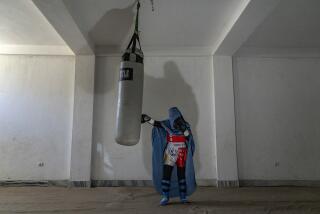Glimpse of Afghan Life by Foreign Journalists Fails to Dispel Mystery
- Share via
KABUL, Afghanistan — As curfew approaches, a foreign visitor on the darkened streets of central Kabul catches a fleeting glimpse of the intrigue of a society divided against itself in a land with a turbulent past.
Men in turbans and knee-length tunics stand watch in the doorways of nearly every lamp-lit earthen hovel in the maze of shelters stretching between towering mountains.
Their eyes dart from side to side, warily scanning the pacing Soviet and Afghan soldiers and the workers and peasants hurrying home after a day of toiling in the factories or trading in the shops.
Rice steams in iron kettles and skewered meat sizzles on grills outside darkened storefronts and doorways as women--some in Western garb, others hidden behind traditional Muslim chadaris --prepare the evening meal.
Streets empty long before the 10 p.m. curfew, but the activity merely moves behind the scenes. A passer-by can hear gravel crunched underfoot beyond the eight-foot walls that enclose blocks of single-story dwellings--often ancient earthen huts or abandoned shipping crates converted to houses.
Men and boys dash from one enclave to another, positioning themselves for the long night that will be punctuated by gunshots in the streets and artillery flashes beyond the surrounding hills.
Foreign visitors, who are few these days, can only speculate on how Muslim rebels opposed to Afghanistan’s Moscow-backed Marxist government carry out their nightly sorties, harassing soldiers in the central streets and in encampments around the capital.
Little can be seen, except the wariness.
Weeklong Visit
About 80 foreign journalists, including about 30 Westerners, were brought to Kabul last month to watch the Soviet Union withdraw 8,000 troops.
The Kremlin has stationed soldiers in Afghanistan since December, 1979, to help the Afghan government fight the Muslim insurgents. Western experts estimate that 115,000 Soviet soldiers remain in the Central Asian country.
The government tried to paint a picture of Afghan-Soviet unity for the journalists. But government obsession with security during the weeklong visit said as much as the artillery blasts, and resentment of the Soviet presence was evident.
In Kabul’s central bazaar, where traders have flocked with silks and spices for millennia, children use Russian words learned from the occupation forces to taunt all fair-skinned visitors, assuming that they are Soviet.
Hatred for Soviets
Western residents of Kabul say they avoid the bazaar for fear of being mistaken for Soviets and attacked.
While I was wandering alone with my camera through a rabbit warren of small knitwear shops, a boy no older than 10 wrapped a length of chain around my arm and jerked me into a poorly lit recess.
“Why did you come here?” he asked in Russian, glaring a mixture of fright and hatred.
He let the chain fall away after I replied in English that I was an American. I wanted to learn what emotions prompted him to grab me, and how he would have responded were I a Soviet journalist. But he spoke neither English nor Russian well enough, and the distrust he emanated encouraged me to find my guides.
The journalists, who were driven daily through the city in an armed bus convoy, tried to make the most of a rare chance to see Kabul and talk with Afghan officials.
But they had little opportunity to probe the complex social, political and religious differences that have fueled Afghan fratricide since an April, 1978, revolution ousted the constitutional monarchy and installed a Marxist government friendly to Moscow.
The Afghan news media treated the journalists’ visit as an event in itself, part of a showy display of gratitude for the Soviet troops’ assistance. The visitors were photographed, filmed and asked for interviews about the “Soviet peace initiative.”
On their final day, they were loaded onto open trucks and paraded through town along with Soviet tanks and personnel carriers.
Afghans loyal to the government lined the streets three-deep and threw flowers at the procession. Soviet tanks sealed off the parade route a block away. Afghan government guides stood watch, apparently for projectiles other than flowers.
No incidents marred the government’s show, but it was apparent that heavy security was needed to protect the procession.
Tight security was the rule throughout the visit. The journalists were barred from leaving the hilltop Intercontinental Hotel without a government interpreter, and Afghan soldiers erected a roadblock halfway down the hillside, on the only road leading to the hotel.
A British reporter and I tried to meet with a Western businessman at the roadblock so he could drive us to a visit with members of the foreign community.
Our insistence that we be allowed to pass upset the teen-age Afghan soldiers, who spoke neither English nor Russian but clearly had been told that no one could come or go without official escort.
They poked at our ribs with the barrels of their machine guns and relented only when an Afghan Communist Party official arranged for our transportation.
Within the security cocoon of the hotel, the visitors were put up in comfortable rooms. Men wearing velvet vests, white harem pants and turbans opened doors and ran the elevators.
On the day of departure, expensive gifts of a handmade prayer rug, marble inlaid boxes and a coffee-table book of Afghan treasures appeared in the reporters’ rooms without explanation. Most of the Westerners left the presents behind.
More to Read
Sign up for Essential California
The most important California stories and recommendations in your inbox every morning.
You may occasionally receive promotional content from the Los Angeles Times.














